Even though relative humidity is frequently measured, long-term accurate stable measurements with a capacitive sensor can be expensive.
This article details an integrated temperature and humidity sensor that provides an optimal overall performance at an excellent price performance ratio based on a novel solution concept.
Other than relative humidity, for a number of applications, the temperature also has to be measured for computing additional humidity parameters like absolute humidity or dew point. Simultaneously, it is essential to consider price restrictions also so that the sensor can be used in a new product design especially in case it is with respect to a secondary measurement parameter.
Disadvantages of Monolithic Integrated Solutions
There are several disadvantages of monolithic integrated solutions, which are being presently offered from a number of manufacturers that include the following:
- Narrow humidity/temperature measuring range
- Poor accuracy
- Unstable behavior around the measuring range limits and
- Unsatisfactory chemical resistance against contaminants
- Dew formation resistance
- Inadequate long-term stability
- Failure during load spikes
- Excessive temperature drift or sensitivity to light radiation
- With regards to the digital I2C protocol and interface, all points do not correlate with the standard.
When considered against the present state of the art technology, the monolithic integrated solutions are not suitable for professional, industrial applications and high quality solutions in the field of micro-system technology are not being seen so far.
Problem Definition
When considered from a processing technology viewpoint, it is accepted that specific polymer sensor manufacturing steps do not comply with the CMOS process, otherwise the semiconductor structure that has been processed will be damaged.
The complexity of manufacturing steps for the sensor layer construction maximizes the production risks and hence the overall throughput of wafers is impacted such that the cost of production increases and the economic manufacturing becomes unfavorable.
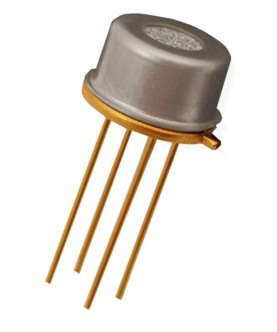
Figure 1. View of the sensor in TO 39 housing
Solution
A logical conclusion has been derived. The polymer sensor must be manufactured with established technology and with optimum layer construction and the surface needs to be drastically reduced using novel manufacturing techniques.
This miniaturized sensor is combined with a matching ASIC optimized based on the application on a common carrier substrate. The connection technique is made cost-effective using standard technologies such as wire bonding and printed thick layer substrate and by connecting to the target system over standard TO sockets or brazed SIL contact strips
The benefits of this solution is an optimum performance for the user over the entire application range, even at the lower range limit at around 0% rH and also at very high humidity and dew formation. Furthermore, it also results in lower manufacturing costs.
Due to this, the ASIC and individual components and ASIC as well as the sensor and carrier substrate can be tested before assembly. Thus, the throughput of the assembled micro-module becomes practically 100%. The resulting optimum price performance ratio is a substantial technological advantage for the user from this production process.
Optimized Polymer Sensor Element
In the product development context, the dimensions of applied polymer of the sensor element can be reduced to 2 x 2 mm. The used, modern high performance polymer on Polyamide base and the layer construction with the innovative implemented, porous shell electrode has been adopted from the design of the previous discrete solution.
The results show that the sensor possesses the same exclusive features with regards to dew formation resistance, chemical and long term stability, hysteresis and linearity similar to the wired models that are well proven for a number of years.
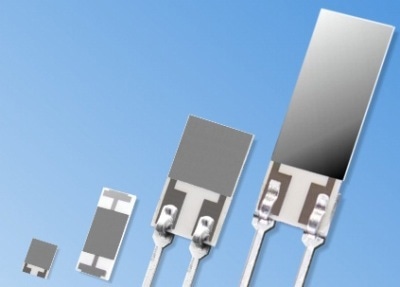
Figure 2. Development history and size comparison
Functionality of the ASICs
The entire signal processing of the physical parameters of humidity and temperature up to the stage of fully processed measured values, which are made available at the I2C compatible interface as digital values is carried out by the applied ASIC.
Hence, the temperature measurement takes place on-chip with high accuracy (better than 0.2 °C) and a resolution of 0.02 K. The complete operating voltage range from 2.7 V to 5.5 V is supported. The average current consumption in the standby mode is only around 1 = A and at a measuring rate of 1 Hz, it is approximately 22 = A, making the sensor ideally suitable for battery operated applications.
The ASIC comprises the internal module cap digital converter (14 bits), a polynomial signal processor, a coefficient memory for the calibrated values and the digital I2C-Interface. The humidity measurement is similarly highly precise: The correction algorithms implemented in ASIC works using quadratic polynomials and ensures computational correction of offset, gain and linearity behavior as well as the temperature drift. Thus the application window is extremely large from 0… 100% rH in the temperature range of -40… 125 °C with a maximum dew point of 80°C.
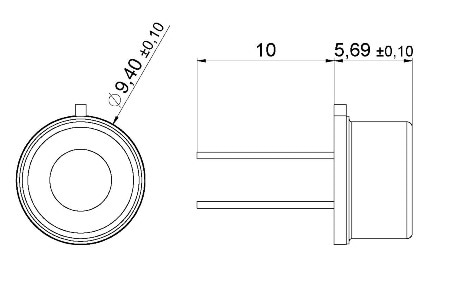
Figure 3. Dimensions
Construction and Dimensions
The polymer sensor element and the ASIC are mounted together on a high quality, mechanically robust thick film ceramic carrier having dimensions of 5 x 5 mm. A quick response behavior is achieved because of the small thermal mass. Both the sensor and the ASIC are bonded.
The structure has glass-filled Globetop protection and is environment-resistant up to the active layer of the sensor element. SMD capacitors are integrated on the module, such that no further decoupling capacitors is needed. The solderable, golden connection pins in the 5.0 mm grid accommodate commercial sockets so that the humidity sensor can be termed as completely calibrated, interchangeable functional module. Optimization of all materials is done for minimum water absorption such that the environment’s microclimate is not affected.
The application temperature range -40 to 125°C is well covered with the used materials. All materials conform to RoHS standards.
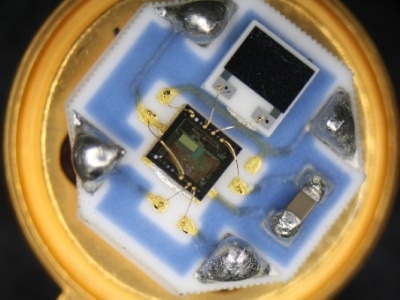
Figure 4. Construction and connection technique.
Calibration
After completing manufacture, the module is precisely calibrated at nine temperature or humidity and also temperature compensated.
Further setting or further adjustment by the user is not required. Both linearity error and temperature drift are already corrected computationally "On chip“, because of which an excellent accuracy is achieved over a wide range of application. The accuracy level of ±1.8 % rH and ±0.2 °C (at 20°C) is higher than all other available competitor's products available in the market. The application range is right from 0… 100% rH in the temperature range of – 40 … 125 °C.
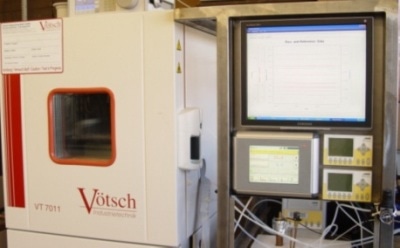
Figure 5. Calibration unit
Digital I2C-Interface
The completely processed physical dimensions of temperature and relative humidity are provided are made available as numerical digital values. Any further setting through the application software is not required helping to save system resources and energy.
The digital interface fully corresponds to the I2C Standard (up to 400 kHz clock rate) and can be used along with other I2C components connected at the same bus. Furthermore to the fixed allotted address, a second address can also be defined. Hence, simultaneous operation of up to 126 sensors is possible at the same I2C bus.
Areas of Application
The innovative component is suitable for almost all applications in which the monolithic designs proved to be unsuitable and which were so far reserved for the discrete polymer sensors.
Building automation: The component encompasses the entire humidity measuring range from 0 to 100% rH and is resistant to dew formation.
Domestic appliances: The component has been tested on the normal household chemicals used in the kitchen and sanitary area (household cleaner, hair spray, etc.) and is long-term stable.
Drying technology: The high performance polymer has proved satisfactory in many industrial drying processes such as tiles, insulating materials and metal chips
Agriculture: The sensor is used successfully in agricultural drying plants (corn, grain, hop, wood). As protection from resin aerosols, a sinter filter is sufficient.
Compressed air systems: The sensor has been tested in plants up to 16 bar for the measurement of pressure dew point (cold and membrane dryer).
Medical technology: The sensor can be sterilized up to 130°C and 2 bar without getting a drift or failing due to such a hard treatment.
Project specific options: The ASIC has further features, which can be made available as a customised model (OEM):
- Instead of the digital I2C-Interface, an SPI Interface is also possible. In this case, the connection is done through 5 pins
- The ASIC furthermore supports two quasi analog PDM outputs for temperature and relative humidity. Hence a quasi analogue output of the measured value is possible.
- Two optional switch outputs enable an additional usage as fixed point hygrostat. A minimum and maximum value can be monitored independently as switch output.
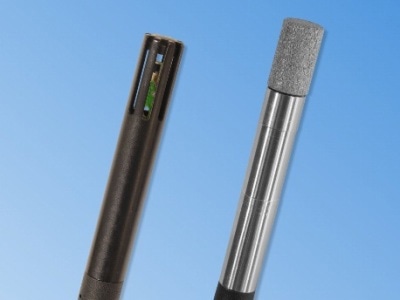
Figure 6. Models in probe housing
Cost-Benefit Optimization
Because of bulk manufacturing benefits and the application’s qualitative requirements, substantial saving potential can be realized with large quantities.
Custom low priced solutions can be manufactured on FR4 substrates. Moreover, the geometry and mechanical dimensions of the module can be adapted to the customer requirements. Also designs with connection housing and with connection leads can be developed and manufactured as per the need of customer projects up to a complete humidity probe with connection leads. Further it is possible to achieve cost optimization as a result of reduction of the used calibration points in the case of alternative inclusion of statistical procedures.
Under certain specifications, even an adjustment at only one humidity-temperature point may be needed, with which a substantial shorter calibration time, and hence, a clear cost reduction may be achieved.
Conclusion
The HYT 939 and HYT 271 incorporate the benefits of a precise, capacitive humidity sensor with the high integration density and functionality of an ASIC. The HYT 939 has a special TO39 housing while the HYT 271 package has SIL- connection pins with a pitch of 1.27 mm for compatibility with commercially available plug connectors.
The sensor is calibrated and provides the processed measured values for relative humidity and temperature, which significantly simplifies the integration into systems. In comparison to monolithic solutions, the high performance polymer of HYT 939 and HYT 271 offers an outstanding chemical resistance and excellent long term stability, even in critical operational areas and with high humidity. The sensor is dew formation resistant.
The bus based interface fully corresponds to the I2C standard up to 400 kHz clock frequency. Using addressing, up to 126 sensors can be operated in parallel at the same bus. Due to the wide operating voltage range and small current consumption, the component is ideally suitable for battery operated applications. In the context of customized projects, product characteristics can be adapted as per application and system costs can be further optimized.
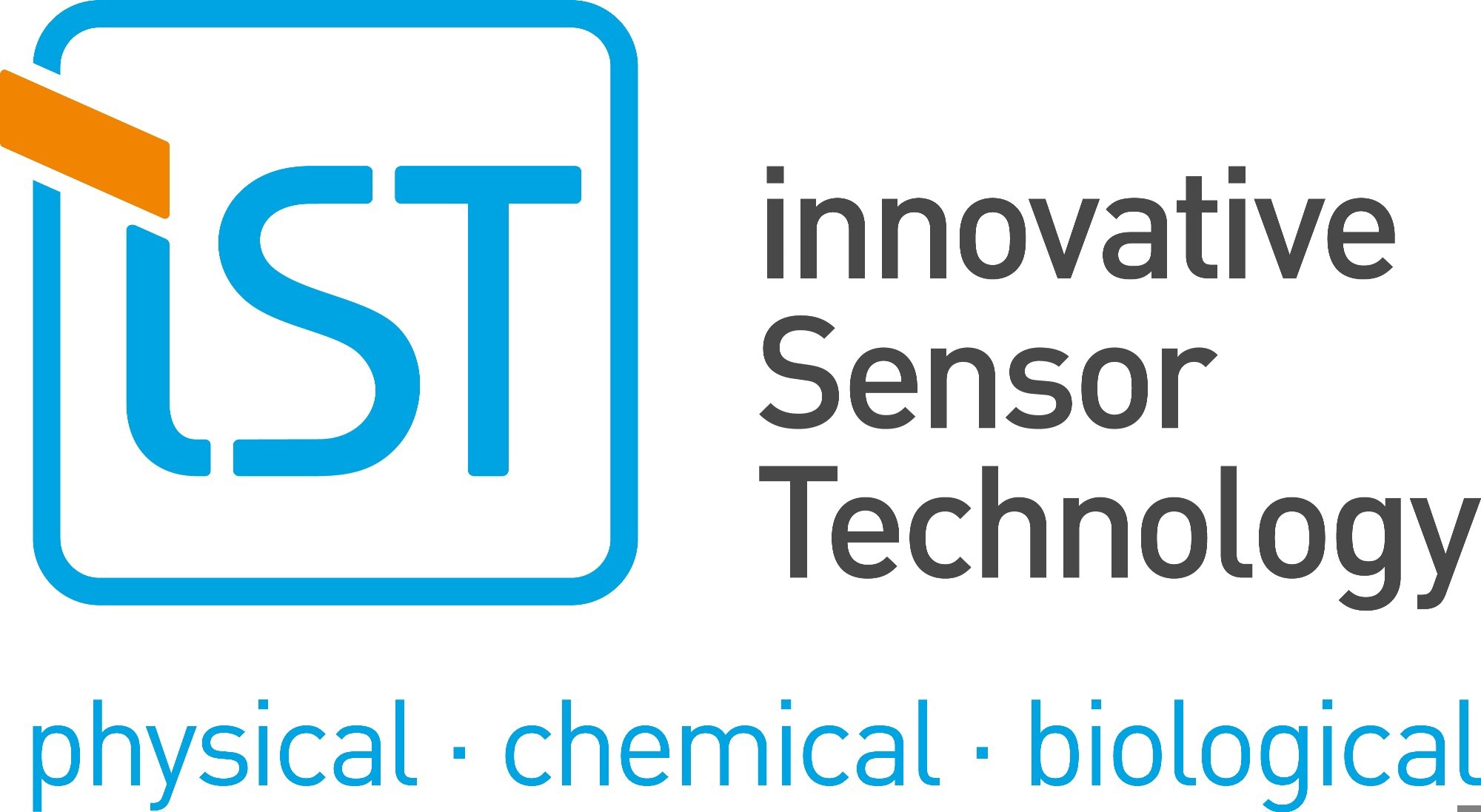
This information has been sourced, reviewed and adapted from materials provided by Innovative Sensor Technology.
For more information on this source, please visit Innovative Sensor Technology.